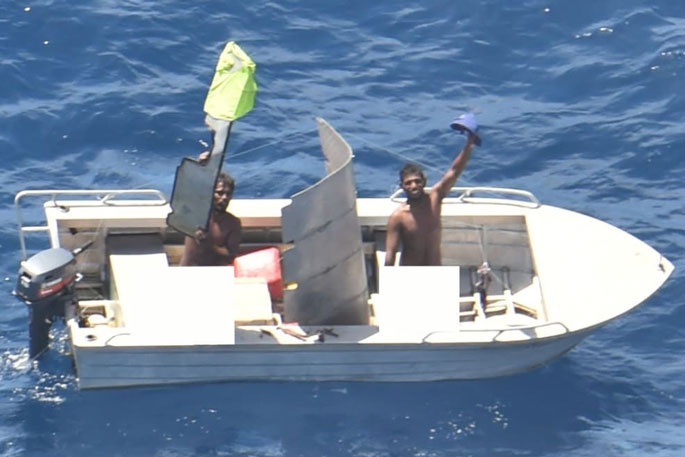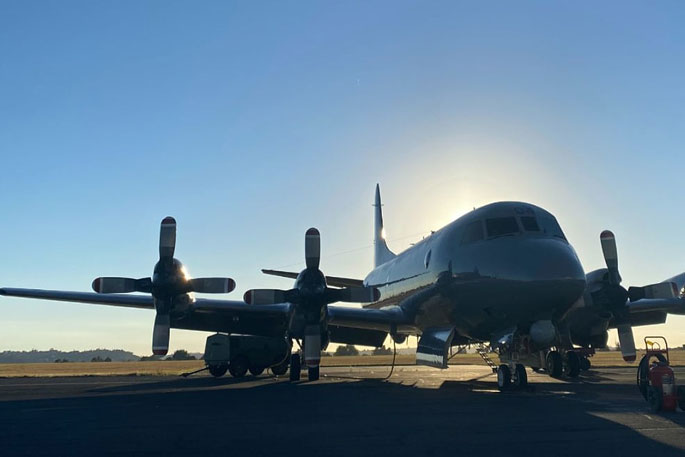An Air Force veteran says a recent rescue of two missing Kiribati fishers was a "fitting" way to retire the branch's Orion P-3K2 fleet after nearly six decades of operation.
But the replacement P-8 Poseidons won't be rescue-ready until July, leaving a gap where the force will be leaning on other agencies and countries to help out with any emergencies.
An Orion crew found the two men in their dinghy shortly after arriving in the search area last week, following an unsuccessful search by a US Coast Guard Lockheed C-130 aircraft. They had been missing for six days.
"It was fitting that once again, the P-3 and its crew have gone out and contributed to a lifesaving mission in the Pacific," RNZAF Air Commodore Shaun Sexton told Morning Report on Wednesday.
"It's done it many times over its 57-year history, and one more in its final month of service was pretty exciting."

New Zealand received five of its six Orions in the mid-1960s, followed by another in the mid-1980s.
"They've had many modifications and improvements over the years - new wings, new avionics and communications and sensor systems," said Sexton.
The unique combination of upgrades over years resulted in their model name being upgraded from the original P-3 to P-3K2.
"They've operated from Antarctica through to northeast Asia, through to Europe - all around the world - but predominantly... supporting our Pacific whanau and neighbours with things like the search and rescue just conducted, and of course supporting New Zealand and surveying New Zealand's EEZs and protecting New Zealand's interests. Looking after New Zealanders with local search and rescues as well."
One of them took its last flight in 2021. The others are being retired earlier than hoped due to "particularly high attrition amongst the skilled workforce that we need".
The Defence Force in 2022 said personnel were being lured out of military careers thanks to growing salaries in the civilian sector.
"The early retirement allows to focus efforts on the P-8, the new Posiedon aircraft which will begin to fly around New Zealand in the coming weeks," says Sexton.
"That'll slowly, over the coming months, build up its capability and start to deliver some of the outputs of the Orion. There will be a period where we will be using some other aircraft, support from partners."
Sexton says the RNZAF "may ask" other countries to help if needed, otherwise they will work with domestic agencies like the Rescue Coordination Centre and National Maritime Coordination Centre.
"But we will be able to use for instance, our Hercules aircraft to provide most of the support that's necessary over this period."
A Defence Force spokesperson in December said the shortage was "exacerbated by the need to also transfer experienced staff in some areas to support the upcoming introduction of the new C130-J-30 Hercules fleet in 2024".
The first Poseidon P-8 arrived in December, and the rest will be here by April. Those already here will be in the air by February, and ready to take part in rescues by July.
"It will take another year after that - so towards the end of 2024 - before the P8 is fully ready, that we've got all the crews trained, the maintenance people ready to go, to deliver the full suite of surveillance and response force outputs that the P3's been delivering all these years," said Sexton.
The US Navy retired its last active duty Orions in 2020, and will phase them out completely later this year, also replacing them with P-8s.
Compared to the Orion, the Poseidon requires fewer crew to operate, is larger, heavier, with stronger engines, a higher top speed and can fly higher.
The Orion is expected to flyover Whitianga this week as as part of three-ship formation flypasts around the North Island to celebrate the fleet's service of more than 55 years.



0 comments
Leave a Comment
You must be logged in to make a comment.